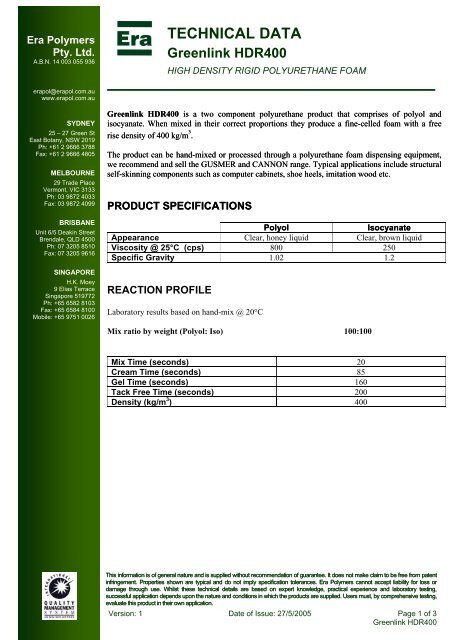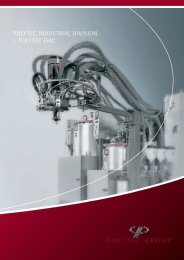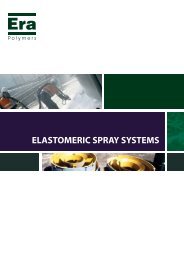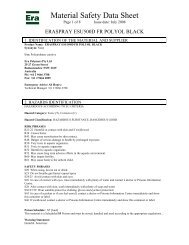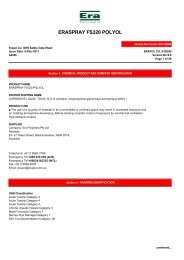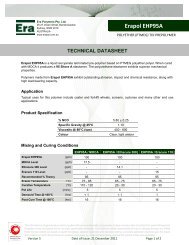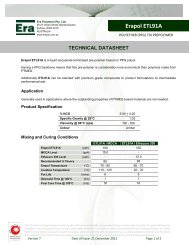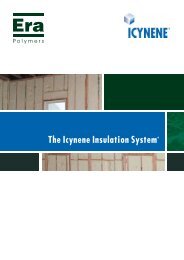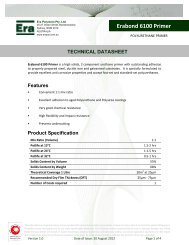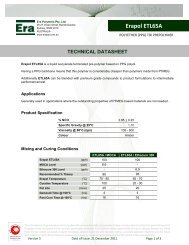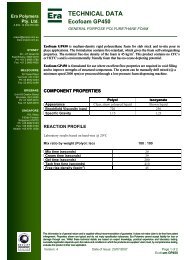Greenlink HDR400 TECHNICAL DATA - Era Polymers
Greenlink HDR400 TECHNICAL DATA - Era Polymers
Greenlink HDR400 TECHNICAL DATA - Era Polymers
- No tags were found...
Create successful ePaper yourself
Turn your PDF publications into a flip-book with our unique Google optimized e-Paper software.
<strong>Era</strong> <strong>Polymers</strong><br />
Pty. Ltd.<br />
A.B.N. 14 003 055 936<br />
<strong>TECHNICAL</strong> <strong>DATA</strong><br />
<strong>Greenlink</strong> <strong>HDR400</strong><br />
HIGH DENSITY RIGID POLYURETHANE FOAM<br />
erapol@erapol.com.au<br />
www.erapol.com.au<br />
SYDNEY<br />
25 – 27 Green St<br />
East Botany, NSW 2019<br />
Ph: +61 2 9666 3788<br />
Fax: +61 2 9666 4805<br />
MELBOURNE<br />
29 Trade Place<br />
Vermont, VIC 3133<br />
Ph: 03 9872 4033<br />
Fax: 03 9872 4099<br />
BRISBANE<br />
Unit 6/5 Deakin Street<br />
Brendale, QLD 4500<br />
Ph: 07 3205 8510<br />
Fax: 07 3205 9616<br />
SINGAPORE<br />
H.K. Moey<br />
9 Elias Terrace<br />
Singapore 519772<br />
Ph: +65 6582 8103<br />
Fax: +65 6584 8100<br />
Mobile: +65 9751 0026<br />
<strong>Greenlink</strong> <strong>HDR400</strong> is a two component polyurethane product that comprises of polyol and<br />
isocyanate. When mixed in their correct proportions they produce a fine-celled foam with a free<br />
rise density of 400 kg/m ³ .<br />
The product can be hand-mixed or processed through a polyurethane foam dispensing equipment,<br />
we recommend and sell the GUSMER and CANNON range. Typical applications include structural<br />
self-skinning components such as computer cabinets, shoe heels, imitation wood etc.<br />
PRODUCT SPECIFICATIONS<br />
Polyol<br />
Isocyanate<br />
Appearance Clear, honey liquid Clear, brown liquid<br />
Viscosity @ 25°C (cps) 800 250<br />
Specific Gravity 1.02 1.2<br />
REACTION PROFILE<br />
Laboratory results based on hand-mix @ 20°C<br />
Mix ratio by weight (Polyol: Iso) 100:100<br />
Mix Time (seconds) 20<br />
Cream Time (seconds) 85<br />
Gel Time (seconds) 160<br />
Tack Free Time (seconds) 200<br />
Density (kg/m 3 ) 400<br />
This information is of general nature and is supplied without recommendation of guarantee. It does not make claim to be free from patent<br />
infringement. Properties shown are typical and do not imply specification tolerances. <strong>Era</strong> <strong>Polymers</strong> cannot accept liability for loss or<br />
damage through use. Whilst these technical details are based on expert knowledge, practical experience and laboratory testing,<br />
successful application depends upon the nature and conditions in which the products are supplied. Users must, by comprehensive testing,<br />
evaluate this product in their own application.<br />
Version: 1 Date of Issue: 27/5/2005 Page 1 of 3<br />
<strong>Greenlink</strong> <strong>HDR400</strong>
<strong>Era</strong> <strong>Polymers</strong><br />
Pty. Ltd.<br />
A.B.N. 14 003 055 936<br />
erapol@erapol.com.au<br />
www.erapol.com.au<br />
SYDNEY<br />
25 – 27 Green St<br />
East Botany, NSW 2019<br />
Ph: +61 2 9666 3788<br />
Fax: +61 2 9666 4805<br />
MELBOURNE<br />
29 Trade Place<br />
Vermont, VIC 3133<br />
Ph: 03 9872 4033<br />
Fax: 03 9872 4099<br />
BRISBANE<br />
Unit 6/5 Deakin Street<br />
Brendale, QLD 4500<br />
Ph: 07 3205 8510<br />
Fax: 07 3205 9616<br />
SINGAPORE<br />
H.K. Moey<br />
9 Elias Terrace<br />
Singapore 519772<br />
Ph: +65 6582 8103<br />
Fax: +65 6584 8100<br />
Mobile: +65 9751 0026<br />
MIXING PROCEDURES<br />
There are a number of ways to successfully produce foam. It is greatly dependant on the type of<br />
mould and desired finish. Two methods will be explained below which highlights the difference in<br />
finish and mould cost.<br />
RIGID MOULD METHOD<br />
This technique utilises simple and low cost mould production. It is limited to relatively simple<br />
shapes.<br />
MOULD MATERIAL<br />
Can be produced from most workable products including wood, aluminium, steel and plaster.<br />
Porous materials such as wood and plaster must be sealed with adequate coats of appropriate<br />
sealant.<br />
MOULD PRODUCTION<br />
• Typically a cavity is formed from the original mould or machined into the mould.<br />
• Moulds are usually two part (base and lid joined with hinges). This type of suit case mould will<br />
allow the mixed material to be poured around in the cavity quickly and easily. It also allows the<br />
lid to be secured quickly and safely.<br />
• The product is rigid foam and is only easily removed from a rigid mould if the cavity has a<br />
slight taper.<br />
• Breather holes (1-2 mm) should be placed strategically around the mould to allow air to escape<br />
during the foaming process.<br />
METHOD<br />
1. Coat the mould with <strong>Era</strong>lease brand release agent.<br />
2. Weigh out Polyol into a clean dry container.<br />
3. Into the same container, add the correct amount of Isocyanate.<br />
4. Drill stir (2,000 - 3,000 rpm) for approximately 20 seconds.<br />
5. Pour mixed material around into the mould cavity.<br />
6. Close lid and clamp shut.<br />
7. Open mould after 10-15 minutes and de-mould carefully.<br />
8. Wipe release agent off foam thoroughly with compatible solvent before painting.<br />
This information is of general nature and is supplied without recommendation of guarantee. It does not make claim to be free from patent<br />
infringement. Properties shown are typical and do not imply specification tolerances. <strong>Era</strong> <strong>Polymers</strong> cannot accept liability for loss or<br />
damage through use. Whilst these technical details are based on expert knowledge, practical experience and laboratory testing,<br />
successful application depends upon the nature and conditions in which the products are supplied. Users must, by comprehensive testing,<br />
evaluate this product in their own application.<br />
Version: 1 Date of Issue: 27/5/2005 Page 2 of 3<br />
<strong>Greenlink</strong> <strong>HDR400</strong>
<strong>Era</strong> <strong>Polymers</strong><br />
Pty. Ltd.<br />
A.B.N. 14 003 055 936<br />
erapol@erapol.com.au<br />
www.erapol.com.au<br />
SYDNEY<br />
25 – 27 Green St<br />
East Botany, NSW 2019<br />
Ph: +61 2 9666 3788<br />
Fax: +61 2 9666 4805<br />
MELBOURNE<br />
29 Trade Place<br />
Vermont, VIC 3133<br />
Ph: 03 9872 4033<br />
Fax: 03 9872 4099<br />
BRISBANE<br />
Unit 6/5 Deakin Street<br />
Brendale, QLD 4500<br />
Ph: 07 3205 8510<br />
Fax: 07 3205 9616<br />
SINGAPORE<br />
H.K. Moey<br />
9 Elias Terrace<br />
Singapore 519772<br />
Ph: +65 6582 8103<br />
Fax: +65 6584 8100<br />
Mobile: +65 9751 0026<br />
FLEXIBLE MOULD METHOD<br />
This technique enables complex shapes to be reproduced easily. The mould construction is more<br />
involved but large production runs are possible.<br />
An original should be made first. Again many materials are available including wood,<br />
aluminium, steel and plaster. Porous materials such as wood and plaster must be sealed with<br />
adequate coats of appropriate sealant.<br />
Make a frame around the original and cast a good quality silicone (<strong>Era</strong> <strong>Polymers</strong> recommend the<br />
Dow Corning Mould Making Silicone range).<br />
Enclose the silicone mould in a suit case type frame.<br />
A release agent is not required with silicones; however, the polyurethane foam will react with the<br />
silicone over a long period of time resulting in hardening of the silicone. To eliminate this reaction,<br />
an in-mould coating is used which has a duel function. It protects the silicone from reacting with<br />
polyurethane foam and the finished foam is coated with a primer (ready for painting).<br />
Method<br />
1. Spray in-mould coating into mould cavity.<br />
2. Weigh out Polyol into a clean dry container.<br />
3. Into the same container, add the correct amount of Isocyanate.<br />
4. Drill stir (1,000 - 2,000 rpm) for approximately 20 seconds.<br />
5. Pour mixed material around the mould cavity.<br />
6. Close lid and clamp shut.<br />
7. Open mould after 10-15 minutes and de-mould carefully.<br />
STORAGE CONDITIONS AND HANDLING<br />
The components are sensitive to humidity and should at all times be stored in sealed drums. The<br />
recommended storage temperatures are 18-25 o C, which will give a normal shelf life of 3 months.<br />
At elevated temperatures problems may arise with pressure build-up within the drums. When<br />
opening these drums extreme care must be exercised in releasing the internal pressure. It is<br />
recommended that the drum contents should be mixed well before use.<br />
HEALTH AND PERSONAL PROTECTION<br />
Before handling these chemicals please consult the Material Safety Data Sheets for the two<br />
components. The polyol component contains tertiary amines. Contact with the skin or eyes must be<br />
avoided. Safety goggles and protective gloves should be worn whenever handling both of the<br />
chemicals. Splashes that come into contact with the skin must be wiped off immediately and the<br />
contaminated area washed with soap and water. Splashes in the eye must be flushed immediately<br />
with plenty of clean running water. If irritation occurs thereafter contact an eye specialist.<br />
This information is of general nature and is supplied without recommendation of guarantee. It does not make claim to be free from patent<br />
infringement. Properties shown are typical and do not imply specification tolerances. <strong>Era</strong> <strong>Polymers</strong> cannot accept liability for loss or<br />
damage through use. Whilst these technical details are based on expert knowledge, practical experience and laboratory testing,<br />
successful application depends upon the nature and conditions in which the products are supplied. Users must, by comprehensive testing,<br />
evaluate this product in their own application.<br />
Version: 1 Date of Issue: 27/5/2005 Page 3 of 3<br />
<strong>Greenlink</strong> <strong>HDR400</strong>


